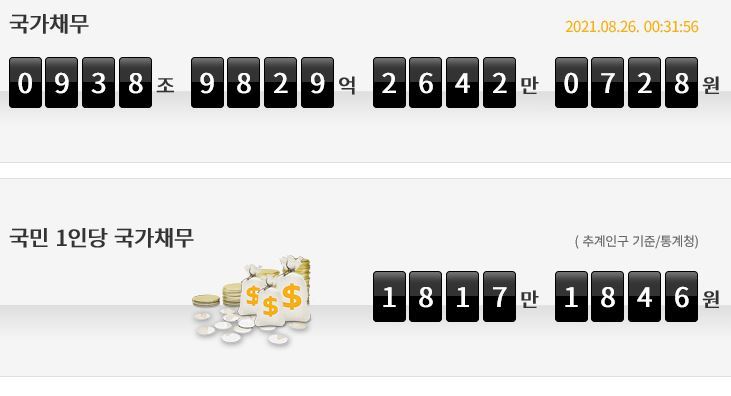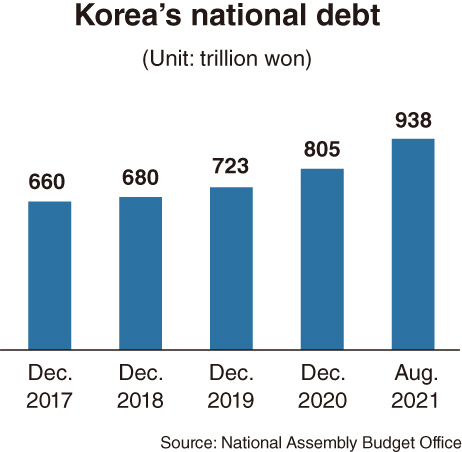[News Focus] National debt surges W100tr in just 9 months
Korean government’s debt-to-GDP ratio headed for 50%
By Kim Yon-sePublished : Aug. 26, 2021 - 16:30

SEJONG -- South Korea’s national debt is estimated to have surpassed 900 trillion won ($770 billion) this year for the first time, though the government has yet to publicize the updated official figure.
According to calculations by the National Assembly Budget Office, the national debt – debt directly held by the central and local governments -- was estimated at 938.9 trillion won as of Thursday. The latest official figure, unveiled by the government, was 898.1 trillion won as of June.
This means the debt total increased more than 100 trillion won in nine months, having first reached the 800 trillion-won mark in November 2020.
And compared to 660.7 trillion won at the end of 2017, it has posted a 42.1 percent increase. The Moon Jae-in administration took office in May 2017.

Last year Korea’s nominal gross domestic product recorded 1,933.1 trillion won, which indicates that the ratio of national debt to GDP is estimated to have approached the 50 percent mark for the first time to reach an all-time high of 48.5 percent.
The estimated figure for August 2021 could mean a surge of about 6 percentage points since the end of 2020, when the ratio was 41.6 percent, but this estimate depends on factors such as the 2021 GDP and whether the Finance Ministry’s purchase of treasury bonds to redeem part of the debt.
The recent debt-to-GDP ratios were 36 percent in 2017, 32.6 percent in 2013, 29.8 percent in 2009, 25.9 percent in 2005 and 17.2 percent in 2001, data from the Ministry of Economy and Finance showed.
Despite concerns over the alarming fiscal health, ruling party lawmakers and government officials have continued to downplay, saying the debt-to GDP level still “far lags behind the OECD average.”
In the wake of the pandemic since early 2020, government expenditure -- including payouts for households and severely-hit industries -- has become more vigorous, on top of full-fledged stimulus packages, such as active issuance of treasury bonds, since before the pandemic.
The opponents have continued to question the efficacy of fiscal expansion via increasing debt under the administration. They pointed to a sharp increase only in non-regular jobs and to disappointing GDP growth -- under 3 percent in 2018 and 2019, and minus 0.9 percent in 2020.
The government refutes the criticism, saying the policies benefited the overall economy.
According to the National Assembly Budget Office, the national debt per capita is 18.17 million won for a population of 51.6 million.
The figure surged by about 2.7 million won in less than a year, compared to 15.42 million won in September 2020, after topping the 13 million-won mark for the first time in February 2018.
Sovereign debt per capita was 11.59 million at the end of 2015. This means that an ordinary citizen’s national debt burden has surged by 56 percent, on an arithmetical basis, in about six years.







![[KH Explains] Hyundai's full hybrid edge to pay off amid slow transition to pure EVs](http://res.heraldm.com/phpwas/restmb_idxmake.php?idx=644&simg=/content/image/2024/04/18/20240418050645_0.jpg&u=20240419100350)






![[From the Scene] Monks, Buddhists hail return of remains of Buddhas](http://res.heraldm.com/phpwas/restmb_idxmake.php?idx=652&simg=/content/image/2024/04/19/20240419050617_0.jpg&u=20240419175937)

![[KH Explains] Hyundai's full hybrid edge to pay off amid slow transition to pure EVs](http://res.heraldm.com/phpwas/restmb_idxmake.php?idx=652&simg=/content/image/2024/04/18/20240418050645_0.jpg&u=20240419100350)

![[Today’s K-pop] Illit drops debut single remix](http://res.heraldm.com/phpwas/restmb_idxmake.php?idx=642&simg=/content/image/2024/04/19/20240419050612_0.jpg&u=)